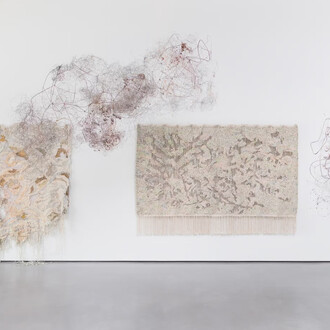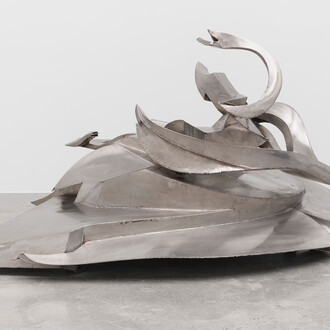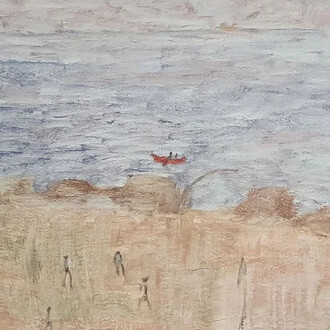Waltman Ortega Fine Art is pleased to present “Five Sculptors”, a group exhibition comprised of works by five international artists: Stevens Dossou-Yovo (born in Paris, France 1969), Jorge Enrique (born in Havana, Cuba 1960), Xavier Escribà (born in Paris, 1969), Alain Le Boucher (born in Paimpol, Brittany, France 1950), and Joe Segal (born in New York City, New York 1963).
The diversity of works exhibited provides real insight into the varying degrees of contemporary sculptural practice, with artworks exploring conceptual and metaphorical allusions to the passage of time, and the cyclical nature of life. There are no explicit narratives or easy answers. But there are always connections – associations of form, memory and meaning – that emerge from these unique pieces. Looking becomes a game of deciphering relationships.
In these three-dimensional structures, the artists work with the formal aspects of spatial relationships, geometricity, proportion, and balance, as a framework for ideas, and as a source of visual power and graphic impact. This is evident in the dynamic energy of Stevens Dossou-Yovo’s wall sculptures. Volumetric, rectangular cells cluster together, creating strange stacked or expanding shapes and voids. Dossou-Yovo’s dense forms work simultaneously as structure, plane and volume. They are the spatial equivalent of energy and growth.
A similar symmetry, reflection, repetition and geometric order are the visual principles of Joe Segal's constructions. Crafted from wood salvaged from buildings, Segal’s elegant sculptures evoke the artist’s reverence and respect for nature. Like the patterns of concentric circles of growth rings in trees – each ring representing a year -- Segal’s sculptures honor the centuries of life reflected in his materials.
Jorge Enrique's painted totems also mark the passage of time. Like silent sentinels, they stand as witnesses to man’s constructed world. Splashed with color, layered with numerals, signs and urban decay, Enrique’s totems function as cultural stratographic columns, markers of the present, and records of the past.
This relationship between present and past is also in the wall sculpture of Xavier Escribà. Forms coil and fold, rise and torque in dynamic trajectories. Created by layers and layers of canvas, sliced into hundreds of strips turned inside out or arranged to suggest biomorphic shapes, boxes or cushions, Escribà frees his forms from the constrictions of subject, to deliver us a conceptual body of work that defines the materialness of art. “I create objects without wanting to. So I have to accept that I make sculptures, even if 95% of my activity consists of painting.” He creates these hybrid works through a slow and persistent process that he loosely defines as the “witness of his experience.”
Fluid kinesthetic movement is at play in the LED circuitry constructions of Alain Le Boucher. Like a glittering web of stars, these pieces propel us into the infinite space of a nighttime sky. There is a shared intentionality in these works – a clarity, an order, and a resolute calmness. Together, these five artists’ works mark the cycles of life, death, and rebirth that are found throughout nature and across time.
Stevens Dossou-Yovo investigates the representation of space through powerful relief compositions. Executed in steel, each sculpture offers a spatial equation of the principles of concentration and expansion. DossouYovo’s work expands on the ideas of optical illusion and tension between opposing forces, producing the optical impression of suspended motion. The metal surfaces of Dossou-Yovo’s wall relief sculptures are given different surface treatments – raw, polished, painted, textured, or abraded with acid. Together, the combination of textures, finishes, and colors form what could be three-dimensional pixelated clouds. Dossou-Yovo studied graphic art, design and interior architecture at the Ecole supérieure de design/School of Graphic Arts Penninghen, Paris, which grew out of the prestigious 19th century Académie Julian. He has been exhibited throughout Europe, including a solo exhibition at the Musée SaintGermain in France.
Jorge Enrique’s work deconstructs the urban environment into layered surfaces, whose visible erasing, abrading, scraping and layering creates a complex physicality of decay, re-use, hidden images, and layers of meaning. Enrique constructs linear, sculptural forms in metal that snake through space with powerful unpredictability. Describing his work as “revved up minimalism,” Enrique is drawn to the intellectual spareness of abstraction and conceptualism, and uses a wide range of media – sculpture, painting, drawing, and silkscreen– to create surfaces that combine the purity of form with the primal exuberance of saturated color and flashes of metallic reflection. Enrique studied at the Alfred Glassel School of Art, Houston in 1991, before returning to Miami where he lives and works.
The work of Xavier Escribà is characterized by transgressing the limits of traditional sculpture or painting by rolling, folding, wrinkling or accumulating torn or manipulated canvas into objects with no premeditated form, exposing layers of colors shown stratigraphically. Escribà studied art in Barcelona (Sant Jordi Fine Arts College, University of Barcelona) and later in Paris (Ecole Nationale Supérieure des Beaux-Arts in Paris). Escribà has exhibited widely over the past 25 years and his work can be found in numerous public collections, including the Fonds Municipal d’Art Contemporain (Paris), the Musée d’Art Moderne de Ceret (France), the Museu d’Art Modern (Tarragona), amongst others. He lives and works in Catalonia.
Circulating in a network of delicate metallic wires, the counterpoint movement and rhythm of lights in Alain Le Boucher’s sculptures continually transform the viewer’s perception of volume. Skeletal, sculptural, electronic and fanciful, Le Boucher programs and formulates his LED sculptures to move with the mystery and precision of the starry night sky. “The light of the stars draws my particular attention -- an attraction which I’ve had since my earliest childhood. I make the acquaintance of astronomers, who like artists are personages on the margin of society, remaining aloof from the dictates of suffocating consumerism.” Le Boucher graduated from the Art Institute of Aix in Provence in 1976, before briefly working in machine design within the Information Technology field. Influenced by Robert Musil and Marcel Duchamp, in 1982 he created the first of his light sculptures he is now so well known for, the Luchrones. Public art and monumental pieces soon became his preferred form of expression beginning with a piece he created for the Paris Museum of Modern Art in 1985. Since then, Le Boucher public works are permanently installed in Bourges, Omans, Reims, and Argeles.
Joe Segal grew up on Long Island before moving to St Augustine, Florida and attending Flagler College where he studied with sculptor Enzo Torcoletti. Segal graduated magna cum laude with a B.A. in visual arts, then returned to New York to study bronze casting at The Sculpture Center. Color, shape, and texture all play important metaphorical roles in Segal’s work. “The structures of the most recent sculptures are made from different pieces of wood joined together as a reference to the harvesting and processing that transforms trees into lumber... Color is used to highlight the dynamic quality of the grain; the energy of the wood; and to emphasize the power of the raw material.”Segal is one of the most innovative sculptors working in Florida, creating compelling art that typically combines manipulated and processed wood with steel or aluminum objects. Public collections in which his sculpture can be found include the Bass Museum in Miami, the Lowe Museum in Coral Gables and the Jacksonville Museum of Contemporary Art.
















